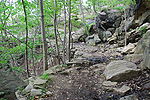

Flirtation Walk is a historic rocky foot trail at the United States Military Academy. The trail follows the shoreline of the Hudson River along the western bank. The southern trailhead starts at the edge of the Lincoln Hall parking lot and winds north along the river around Gee's Point and the West Point Light. The trail turns west-northwest, passing Battery Cove, where the Great Chain was anchored during the Revolutionary War. The trail ends near the helipad of West Point's North Dock. There also is an access trail that descends steeply to the river level from Trophy Point. The trail varies in consistency from level and even to steep and rocky. By academy tradition, only cadets and their guests may use the trail. Visitors escorted by cadets should wear sturdy shoes. The 1934 film Flirtation Walk was named after the trail. The film was nominated for the Academy Award for Best Picture.

Cadets refer to it as "Flirtie Walk", or just "Flirtie". The cadet knowledge manual, known as Bugle Notes, refers to Flirtation Walk as a "scenic walk where only cadets and their escorts may go."[1] The trail was first used during the Revolutionary War to access the Great Chain that deterred British ships navigating the turn in the river. As it originally had a military application, this path was off limits to cadets until the 1840s. After the military garrison's purpose at West Point became obsolete, the trail was opened and encouraged to be used by cadets. As the academy grew in size in the mid-19th century, more visitors began to frequent the cadets. Given the limited transportation opportunities of the day and the lack of places for the young men of the academy to take their lady guests, the walk became a popular place to go. The administration of the academy allowed cadets the rare opportunity to have some privacy with their guests.[2] This policy is still traditionally held and signs are posted to keep visitors to the academy away from the trail. The signs read "Visitors must be accompanied by a cadet".
- ^ "Information for New Cadets and Parents, Class of 2011" (PDF). United States Military Academy. p. 26. Retrieved 2010-06-05.
- ^ Lopez, Kathryn. "Interrogatory: interview with the author of Last in Their Class: Custer, Pickett and the Goats of West Point". National Review Online. Archived from the original on 2011-06-16. Retrieved 2010-06-05.